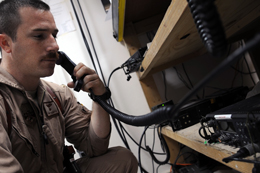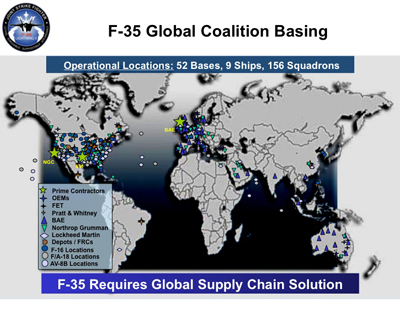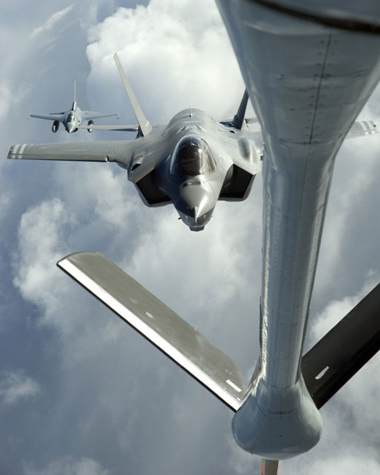SLD sat down with Chris Sheppard, a manager of USAF programs for Northrop Grumman Corporation’s government relations group, to discuss the interaction between the F-16 and F-35 as the U.S. Air Force builds its capabilities into the 21st century. We asked Chris to share his personal experience as an F-16 pilot, his work on the F-35, and how the two compared. Chris works at the Fighter Demonstration Center in Arlington, Virginia, a facility shared by Lockheed Martin, Northrop Grumman, and Pratt and Whitney set up to showcase the Fifth Generation Fighter capabilities. Chris Sheppard has flown all F-16 blocks, “A through D,” he says, and has closely followed the fighter’s evolution from block to block in his current line of work at Northrop Grumman. A graduate of the Air Force Academy, Chris Sheppard is now an Air National Guard F-16 pilot and has flown F-16s operationally on active duty and with the reserve component, and participated in a number of combat exercises including Operation Northern Watch, Operation Southern Watch, and Operation Iraqi Freedom.
The F-35 is intended as the replacement for the F-16. This interview explores how the new fighter will execute future missions differently, as well as how the two fighters may work together during the transition. We also discussed with Chris Sheppard how customers can get greater connectivity between the two aircraft.
***
Designated the AN/AAQ-37, and comprising six electro-optical sensors,
the full EO DAS will enhance the F-35’s survivability and operational effectiveness
by warning the pilot of incoming aircraft and missile threats,
providing day/night vision and supporting the navigation function
of the F-35’s forward-looking infrared sensor
(Credit: DoD Joint Program Office)
SLD: Chris, thank you for taking the time to sit with us. So let’s get back to basics here. What is an F-16 and can you describe its mission?
Chris Sheppard: You’re welcome, I’m glad to be here. The F-16 is a highly maneuverable, combat proven multi-role fighter aircraft designed and developed in the late 1970’s to execute air-to-air combat and air-to-surface attack missions. Its purpose was to provide an affordable, high-performance weapon system, not only for the United States, but also for partner nations.

Chris Sheppard: Let’s talk about this in terms of what industry calls ‘block evolution’. The F-16A refers to the Blocks One through Twenty, single seat aircraft; the F-16C began with the Block 25, and now we’re up to Block 52+ in this evolution. The ‘Block’ is an important term that traces the F-16s evolution in capability. Without changing the outer mold lines of the aircraft, we’ve been able to add capability with each subsequent Block and adapt the aircraft to continually changing roles and missions.
The F-16’s roles and missions are continuing to evolve. The F-16 has evolved to be a real workhorse for US and allied nations in many mission areas including air-to-air, air-to-ground, and close air support. It has also proven significant in the dynamic targeting role, which we call DT, and the non-traditional intelligence surveillance and reconnaissance (ISR) role, to help troops on the ground conduct their missions.
Two pertinent missions we’re executing today in the ISR role are armed overwatch and armed reconnaissance. Obviously, the original mission of the aircraft was to deliver kinetic effects when called upon in accordance with the rules of engagement, but now we’re also utilizing the aircraft as an ISR platform to maximize the value of the time we’re getting from the aircraft while airborne. The SEAD and DEAD roles — the suppression of enemy air defenses and the destruction of enemy air defense roles — have evolved through Block upgrades on the aircraft also.
SLD: When the Air Force introduces the F-35, it will likely include some of these F-16 missions and capabilities but overall the F-35 provides a very different capability. How would you distinguish the two aircraft and how will the F-35 affect the missions sets with which the F-16 has been tasked?
Chris Sheppard: The legacy fourth-generation fighters, which we speak of being F-15s, F-16s, F-18s, have become more stealthy over time with each subsequent block upgrade as they have taken on some low observable treatments to help achieve a little more stealthiness. It’s really the advanced avionics upgrades that have always been a cornerstone of the new Blocks. Also, by leveraging global positioning systems (GPS) and laser-guide technologies, these aircraft become more effective and precise kinetically armed assets, especially with the evolution of advanced precision-guided weapons.
But there are inherent limits to upgradeability of the legacy aircraft. The fifth-generation aircraft, the F-22 and F-35, are built from the ground up with many advanced capabilities in mind that can’t be attained from adding on or strapping on pods, et cetera, to ‘fourth-generation’ aircraft.
Fifth-generation aircraft are designed from the ground up with very low observable stealth. This is very important from a threat perspective in the advent of already-fielded and future radar, avionics, and weapons. There’s also integrated sensor fusion, where primary sensors – like the APG-81 in the case of the F-35 – are highly integrated with the Electronic Warfare system or the electro-optical Distributed Aperture System (DAS). Sensor fusion is the kind of visceral capability that can’t simply be added to legacy aircraft or retrofitted on later. Sensors and accompanying software must be part of the design architecture from the get-go for fusion-compatible applications. There are other aspects as well — net enabled operations, the ability to gather information and then share the information with users who need the data real time.
As I mentioned before, the F-16 was developed in the late 70’s with countries in the European Participating Air Forces (EPAF). Similarly the F-35 is being developed with eight partner nations, and in the United States with three services, the Air Force, the Navy and the Marine Corps. In addition, we have security cooperation partners who participate in the Program, with prospective foreign military sales; other countries are already inquiring about the aircraft.
All of these partners will help the coalition with basing options, and the overall team capabilities will be significant. The fleet will have range and persistence, and as I mentioned earlier, the sensors; and the ability to share the information as a team versus having systems that don’t communicate or aren’t designed from inception to communicate with each other.
While the F-16 has gained impressive capabilities with each subsequent Block upgrade, the one core difference with the F-35 is the bottom up approach for integrating capabilities. This includes stealth. Integration is a central idea from the beginning. The F-35 brings all partner nations into a unified advanced warfighting and interoperability standard in one giant leap.
SLD: This fact of integration, plus an open architecture, will allow an easier upgrade process: those are two very important discriminators in thinking about the F-35 versus the legacy aircraft. Because Northrop Grumman supports so much of the integrated aspects on the aircraft in terms of the sensors and the AESA radar, could you comment a little bit about the advantage of integration and the advantage of this kind of foundational upgradability?
Chris Sheppard: I’ll cover them in sequence.
- Fifth-generation fighters bring one main advantage to the war fighter and to the combatant commander: survivable situational awareness. Situational awareness, by definition, is the perception of environmental elements within time and space, being able to comprehend the meaning of all the data coming in and then being able to project the status in the near future. In today’s battle space, there’s much more data being thrown at war fighters near-simultaneously. It’s imperative fighters—for tactical and strategic reasons—to have complete, accurate, and up-to-the-second situational awareness.
With all this technological and situational complexity on one human decision maker, the benefits of the F-35 stand out and here’s why. First and foremost, you have to have the sensors on board to gather the information that you need to target, pass intelligence, surveillance and reconnaissance information, or–if need be–deliver kinetic effects on a target. Northrop Grumman provides the Active Electronically Scanned Array (AESA) radar; the Distributed Aperture System (DAS); data link; communication, navigation, and identification system, in addition to the center fuselage structure of the aircraft. The avionics systems work in concert with each other and play key roles in making sure actionable intelligence is there, at the ready. - The second thing you need is fusion, the ability to take information from all these—and other–sensors (on or off board) and fuse together in a manner such that the human decision maker isn’t assimilating all this while flying and trying to apply rules of engagement, et cetera. Having the ability to fuse this information together and make it actionable is key.
- Thirdly, we must be able to display this information in a manner in which a human decision maker can make tactical—and strategic–decisions. The first priority for the pilot is to execute tactics and not to be caught in a quandary of wondering whether information is valid or not. Data needs to be presented as valid right away. The F-35 and the F-22 have the displays which allow the pilot to make decisions with confidence and execute in accordance with the rules of engagement.
- Lastly, the fifth-generation fighters bring the ability to network and the road maps to get this data off the platform to either element mates in the formation, to members of the coalition who are flying other F-35s in the battle space, or to get the data on to the ground when needed. F-35 fulfills the non-traditional ISR role when the guys and gals on the ground are using information garnered from the F-35’s sensors or information is being passed back to various operation centers.
And so those four elements of situational awareness — the sensors, the fusion, the display and the ability to network —, I think, really make it stand out above all ‘fourth-generation’ aircraft.
SLD: What about the impact on the upgrading process?
Chris Sheppard: Upgrades are needed just as quickly as we experience technology shifts. Modular, open system architectures are a key core competence of what we at Northrop Grumman bring to the fight. The customer has invested billions of dollars in these aircraft to provide hardware and software solutions that are common and leverage that investment across platforms, including fourth-generation fighters.
SLD: What effect do the global partnerships have on leveraging investments, since really for the first time, multiple players are investing concurrently?
Chris Sheppard: The global investment in the F-35 translates into unprecedented operational flexibility for our teammates worldwide. It’s going to provide an advanced sustainment model that changes the logistics and services paradigm. This aircraft is going to be around for many, many decades. We’re still building F-16s and the first one was delivered in 1978–who would have imagined? I believe Lockheed Martin has delivered over 4,500 F-16s worldwide which is truly amazing and testament to the those who build, fly, and maintain the aircraft.
 Credit: DoD Joint Program Office
Credit: DoD Joint Program Office
SLD: What can you say about the F-35 as far as providing the man-in-the-loop in an era where we’re seeing the deployment of so many UAV platforms?
Chris Sheppard: I think that there are tradeoffs between the unmanned and the manned aspects of flight. It kind of snuck up on us and it happened very quickly with the advent of 50 plus UAS combat air patrols. I think that the persistence that those platforms provide is invaluable. I think that they offer advantages with regard to niche capabilities based on the physical flight characteristics of those platforms.
They still have, in a sense, a human in the loop, albeit not in the cockpit. I think the F-35, from a fighter perspective, is able to leverage its ability to have a real time decision maker on the scene, communicating via voice and every other means with which the aircraft can communicate, certainly fills many of the gaps that occur in the plethora of situations in combat, or in the overseas contingency operations we’re engaged in, that can’t be filled by an unmanned platform.
———-
*** Posted on March 22nd, 2010


